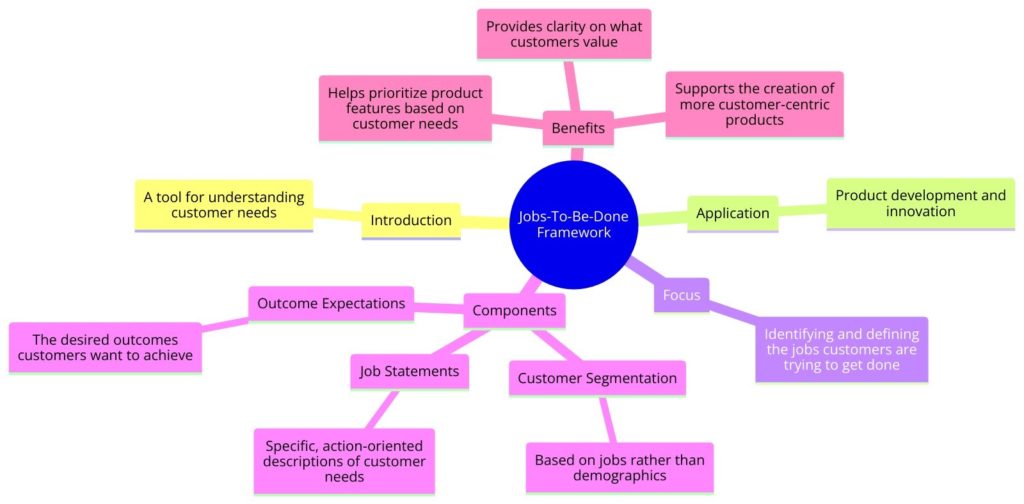Jobs-To-Be-Done Framework
The Jobs-To-Be-Done Framework (JTBD) is a tool for understanding customer needs in product development and innovation. It revolves around the idea that people “hire” products or services to get a “job” done. The framework shifts the focus from demographic data to the underlying motives driving customers’ actions, offering deeper insights into what truly influences purchasing decisions. By identifying and understanding these jobs, businesses can create or improve products that effectively address real customer needs.
What is the Jobs-To-Be-Done Framework?
The JTBD Framework is based on the premise that customers buy products and services to solve specific problems or fulfill certain needs, referred to as “jobs.” These jobs can be functional (accomplishing a task), emotional (achieving a particular feeling), or social (influencing how others perceive them). The framework helps companies to innovate and improve by focusing on the Job rather than the product itself, thereby aligning product development with customer needs more accurately.
Origin of the Framework
While the concept of focusing on customer needs was not new, the formal JTBD Framework was popularized by Clayton Christensen, a professor at Harvard Business School and the author of “The Innovator’s Dilemma.” Christensen introduced the framework as a tool for better understanding customer motivations and behaviors, especially in the context of innovation and disruptive technologies.
How It Works
The JTBD Framework involves several key steps:
- Identify the Job(s): Determine the primary job customers are trying to get done by using a product or service. This involves understanding the context in which customers use the product and the specific outcomes they are trying to achieve.
- Break Down the Job: Analyze the Job into specific tasks, considering all dimensions of the Job, including functional, emotional, and social aspects.
- Understand the Job Context: Explore the circumstances under which the Job is performed, including pain points and constraints that affect how the Job is done.
- Define Job Performance Criteria: Identify what success looks like for the customer in getting the Job done, including metrics or attributes that customers use to measure success.
- Innovate: Use insights gained from the analysis to develop or improve products and services that more effectively address the identified jobs.
Why It Is Valuable
The JTBD Framework is valuable for several reasons:
- Customer-Centric Innovation: It ensures product development is grounded in actual customer needs, increasing the likelihood of market success.
- Competitive Differentiation: Understanding the Job to be done offers a different perspective that can reveal unique opportunities for differentiation.
- Better Market Segmentation: It allows for more effective segmentation based on needs and behaviors rather than demographic factors, leading to more targeted marketing strategies.
- Enhanced Customer Retention: Products designed to do a job effectively are more likely to satisfy customers, leading to higher retention and loyalty.
When and How to Use It
The JTBD Framework can be used at various stages of the product development cycle, including:
- Conceptualization: For identifying new product opportunities.
- Design: To refine product features and functions.
- Marketing: For developing messaging that resonates with customers’ underlying needs.
- Strategy: To evaluate and prioritize product development initiatives.
Implementing the JTBD Framework involves conducting in-depth customer research, including interviews and observations, to uncover the jobs customers are trying to get done. It requires cross-functional collaboration between marketing, product development, and customer research teams.
Shortcomings/Criticisms
Despite its strengths, the JTBD Framework has faced criticisms:
- Implementation Complexity: Effectively identifying and analyzing jobs can be challenging and time-consuming.
- Overemphasis on Individual Jobs: Focusing too narrowly on specific jobs can sometimes overlook broader customer needs or market trends.
- Adaptability: Some argue that the framework is less effective in rapidly changing markets where customer jobs evolve quickly.
The Jobs-To-Be-Done Framework provides a powerful lens for understanding customer needs and motivations, guiding more effective product development and innovation strategies. By focusing on the jobs customers need to get done, companies can create products and services that truly resonate with their target audience. While the framework may present challenges in implementation, its potential to drive customer-centric innovation makes it an invaluable tool for businesses aiming to compete effectively in today’s dynamic market landscape.


